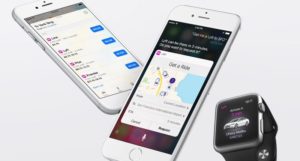 I was going to be using Lyft a few times one day, so, in anticipation, I decided to put the Lyft app on my Apple Watch, only to find out that there wasn’t a Lyft watch app any more (removed in May). Lyft joins a long list of big brands forgoing any app presence on the Apple Watch, a list including Twitter, Google Maps, Amazon, Instagram, and eBay.
I was going to be using Lyft a few times one day, so, in anticipation, I decided to put the Lyft app on my Apple Watch, only to find out that there wasn’t a Lyft watch app any more (removed in May). Lyft joins a long list of big brands forgoing any app presence on the Apple Watch, a list including Twitter, Google Maps, Amazon, Instagram, and eBay.
MacRumors thinks the exodus of app makers from the Apple Watch might be due to an SDK change. I actually think it’s more serious than that: none of these companies know how to get any value from an Apple Watch app.
Expensive notification Watch
Lyft has chosen, like many others, to not have a Watch app, but to relegate the Watch to surfacing notifications from the app on the phone. The Watch is indeed excellent for managing notifications in a discrete way. And aside from telling time and being a fashion (or nerd) statement, this might be the Apple Watch’s biggest use case.*
But the Apple Watch can be much more than a notification surface on your wrist. And I think most app developers don’t understand how to take advantage of a wrist-based surface.
I’ve seen this kind of blindspot to a new mobile modality before when smartphones and mobile-based web browsing were just starting, back in 1999. Back in the day, folks accustomed to desktop computers did not understand, what I called, the Mobile Lifestyle, how being mobile changes the way we use devices. And just look at how different the app store today is from the app store when it launched 10 years ago.
Likewise, we’re now so stuck with these amazing smartphones, that folks are having a hard time understanding how smartwatches fit into the current smartphone lifestyle.
Case in point: many folks want full phone capabilities in their smartwatch, much like folks wanted full desktop capabilities in smartphones, back in the day. The way we use smartphones today, dominated by snacking, ubiquitous info, and real-time connections to social networks took a long time to coalesce, and is quite different from how we use desktop computers (though tablets are starting to blur these distinctions and provide an interesting continuum of digital experiences).
The Watch Lifestyle
We’re at an early stage with smartwatches and folks need to stop thinking of how they use smartphones and try to shove the smartphone experience into their watch. Designers need to take a fresh look at how a wrist-top haptic and interactive surface can provide value to users. You can get an idea by observing the phone-watch connection between Apple-branded apps on the iPhone and on the Apple Watch (though the flow can be a bit fragmented or sometimes stupidly asymmetrical). And I’ve mentioned the Nike+ experience, before.
While I don’t think all apps benefit from a Watch app, I do think that some brands that have left in the exodus could benefit. The challenge is to think differently, rather than just port the phone experience to the watch.
Apple’s role
Also, I am not sure where the break down occurs, as I have heard complaints about APIs Apple makes available on the Watch, such that it’s easier to just surface notifications than to design a great integrated iPhone-Watch experience. I will admit that I have no clue as to the APIs on the Watch, but I do know where I would take the experience if I were designing a Watch app. Does Apple?
Early days
We’re still in the early smartwatch days and I haven’t seen yet any significant exploration of the Watch experience. Most developers are defaulting to notifications and missing a great opportunity to transform the value smartwatches can bring to users.
And that’s a shame.
What do you think? Does your company have an Apple Watch app? Do you want to design one? Why? How? Let me know.
*Ever interested in customer insights, I regularly accost folks who have smartwatches and ask why they bought it, how they use it, and what’s missing. The coolness factor (fashion) and notifications are the most common answers for purchase and use. Better notification (the apocryphal “faster horses”) is usually what’s missing, suggesting there’s still room to wow the user with a better experience. Indeed, a survey last year showed notifications as the top use for smartwatches, with activity tracking the close second.